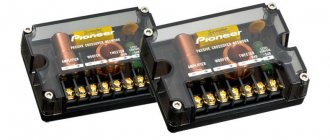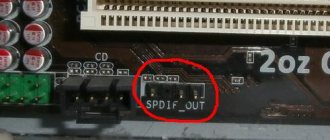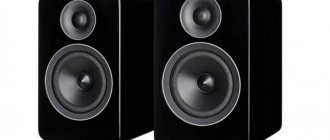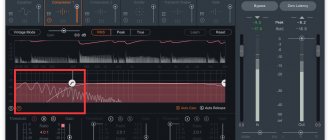In the “Bass Territory” section, we continue to publish translations of materials from the blog of John Hunter, owner and chief developer of the British company REL, a world-famous manufacturer of subwoofer systems.
Save and read later -
One day, an angry Hi-Fi veteran called REL and started asking: “Why don’t you use normal closed enclosures for ALL models?” It’s as if when creating subwoofers it is customary to follow some kind of sacred rule, which allows only the “true” design of the housing - sealed. In this regard, we decided to touch on some technical aspects of active and passive speakers, the shape and size of the housing for different models of subwoofers. We hope this helps you find answers to some of your questions.
With all due respect to the nice gentleman who hung up the phone in annoyance, it is worth noting that with subwoofers it is not so simple.
There is no single recipe for all occasions. We use two main approaches: a closed enclosure or a design with front-facing main speakers acoustically coupled to passive radiators mounted in the bottom of the enclosure.
Several decades ago, two Australians, Thiel and Small (obviously due to the rush of blood to the head, since they walk upside down on the other side of the Earth!), conducted a study of the parameters that determine the behavior of speakers and their interaction with the cabinet. One of the most important findings of their work is the realization that the larger the case, the softer the air “spring” inside it. That is, to get the full benefit, no additional tricks are required from the body design. At the same time, speakers designed to be placed in small enclosures can be equipped with a softer and more elastic suspension, allowing a fairly long cone stroke.
Acoustic design with passive radiator (PI). Calculation and setup
There is another type of acoustic design of a loudspeaker that can ensure that the loudspeaker reproduces low frequencies with relatively small dimensions of the box. It has several names, of which the most correct are: bass reflex with a passive radiator or FI with a closed hole. This design is also called a passive radiator (PI) or passive radiator.
The peculiarity of this bass reflex is that the loudspeaker is placed in a box that has a hole near its installation site, with a movable system of a second loudspeaker fixed in it without a magnetic system and a centering washer. The diameter of the passive radiator cone is approximately equal to the diameter of the loudspeaker cone. The hole in the voice coil is sealed and in this place an additional weight is attached to the diffuser. The weight of the load depends mainly on the volume of the box and the resonant frequency of the bass reflex.
The principle of operation with a passive radiator is similar to the principle of operation of a conventional bass reflex. At the resonant frequency of a closed FI, the diffuser of the passive radiator oscillates in phase with the diffuser of the main loudspeaker, ensuring effective signal reproduction in the low-frequency region. Thus, unlike the main bass reflex, here the mass in the hole is replaced by the mass of the movable passive radiator system, including an additional weight.
The weight allows you to more simply than is done when measuring the size (volume) of the passage in a conventional bass reflex, to regulate the resonant frequency of the bass reflex. When reducing the volume of the box of a conventional bass reflex, it is necessary to increase the volume of the passage or reduce the area of the hole, which reduces the efficiency of the bass reflex. A bass reflex with a closed hole is free from this drawback and this is its main advantage.
Passive radiators found application in acoustic systems of the USSR era, such as: “25 AS-128 Electronics” and “35 AS-015 Electronics” . In modern speakers, this design is used in PMC IB2i or the Sunfire True Subwoofer . A passive radiator can be of almost any shape, round, square or oval, for example, as shown in the photo below:
Another positive quality of a bass reflex with a closed hole is a slightly greater in-phase movement of both diffusers in the resonance region compared to the movement of the air volume in the hole and the speaker cone in a conventional bass reflex. The resonant frequency of a bass reflex with a closed hole is equal (as well as a conventional one):
fф = 1 : (2Π · (√mф · Сф)), where
The calculation of a bass reflex with a closed hole is carried out as follows: by choosing the volume of the box Vf and knowing the effective diameter of the diffuser of the passive radiator Deff , determine the flexibility of the air volume from the expression:
Deff =0.85-0.9 Ddiff , where
The equivalent effective diameter of an elliptical (oval) diffuser is:
Deq.eff = (0.85 – 0.9) · (√Db · Dm), where
Since the flexibility of the diffuser suspension of the passive radiator Spod is much greater than the flexibility of the air volume of the box Sf , its influence on the total flexibility is extremely small and can be neglected. Overall flexibility is determined by the formula:
Ctotal = (Spod · Sf) · (Spod + Sf)
Spod >> Cf, Commun ≈ Cf.
Taking, as usual, the resonant frequency of a closed phase inverter equal to the main resonant frequency of the loudspeaker, find the mass mf corresponding to this frequency and the flexibility of the selected volume:
mf = 1: (4Π 2 ff 2 Sf)
As mentioned above, this mass includes the mass of the passive radiator diffuser mrad and the added mass of air oscillating with it Δm , i.e.:
mf = mrad + Δm.
The value of Δm depends on the effective diameter of the diffuser and is determined by the expression:
Thus, the radiator diffuser must have the following mass:
mrad = mf – Δm;
In practice, this value will be equal to the mass of the load that needs to be installed on the diffuser. To facilitate the necessary calculations, the table shows the values of volume flexibility Cf for boxes with a volume of 20 to 80 liters and passive radiator diffusers with an effective diameter of 15 to 22 cm, and also indicates the value of the attached air mass Δm for the same diffuser diameters.
The flexibility value of the air volume in boxes with intermediate values and the effective diameter of the radiator diffuser is determined by interpolation using two adjacent flexibility values, between which the accepted dimensions are located.
As an example, let’s determine the mass of the load that must be mounted on a passive radiator diffuser with a diameter of Ddif = 22 cm, installed in a box FI with a volume of Vph = 50 l at a resonant frequency of FI of 45 Hz. Effective diameter:
Deff = 0.87 → Ddiff = 0.87 · 22 = 19 cm.
Using the table, we find the flexibility of the air volume in the box with such an effective diffuser diameter: this flexibility is equal to:
The total mass of the diffuser should be:
mf = 1: (4Π 2 ff 2 Sf) = 10 6: (4Π 2 45 2 0.44) ≈ 28.4 g
The added mass of air, according to the table, is equal to Δm = 5.5 g. Therefore, to obtain a given resonant frequency, it is necessary to install an additional weight:
mrad = mf – Δm = 28.4 – 5.5 ≈ 23 g
The additional load is a steel or copper (brass) disk with thickness h , which for steel, depending on the diameter of the disk d , is equal to:
h = (0.16 mrad): d 2
As stated above, the magnetic system and centering washer are removed from the speaker designed to function as a passive radiator. This is done in order to increase the flexibility and linearity of the movement of the moving system, and eliminate the danger of touching the voice coil. This does not reduce the effective volume of the box. An idea of the design of a passive radiator installed next to a loudspeaker is shown in the figure below, which shows how an additional weight in the form of a disk is attached to the center of the diffuser with a bolt and nuts. The hole in the diffuser is sealed with a piece of hard paper (whatman paper or thin cardboard) with teeth glued to the diffuser with celluloid or other glue, for example BF-2. It goes without saying that the fundamental resonant frequency of a loudspeaker designed for a passive radiator does not matter at all. Or you can buy ready-made passive radiators; they are now widely available.
CONTENT
One of the varieties of phase-inverted acoustic systems is speakers with PI. It differs from a closed speaker by the presence of an additional moving system (in the simplest case, a moving system of a low-frequency head without a coil and magnetic circuit) (Fig. 61).
This system is passive and is excited by air vibrations in a closed housing when the head is operating, emitting sound waves in the low frequency region. As a result, the total sound pressure developed by a speaker with a PI at low frequencies can be significantly greater than a closed speaker of the same volume and with the same low-frequency driver. The design of speakers with PI is shown in Fig. 62.
According to the principle of operation, AS with PI is similar to AS with FI. The only difference is that the mass of air in the bass reflex tube is replaced by the mass of the moving passive radiator system.
Rice. 61. Direct treatment head (a) and passive radiator (b)
[/td]
By changing the mass of the moving system of a passive radiator, it is possible to change its resonant frequency much easier compared to a bass reflex, where this required changing the hole size, diameter or length of the pipe.
Rice. 62. Design of speakers with PI: 1 - passive radiator; 2 - low-frequency head 3 - high-frequency head
It was previously noted that AS with FI has a number of design limitations. Thus, when setting the bass reflex to a low resonant frequency (30-50 Hz), the air mass in the pipe must be quite large, which is usually ensured by either increasing its length or decreasing its diameter (with a constant internal volume). In the first case, it may turn out that the pipe structurally will not fit into the design, or its length will exceed the critical value λn/12 . In the second case, acoustic friction losses in the pipe may increase sharply, which will reduce the efficiency of speakers with FI in the low-frequency region.
Speaker systems with PI are free from these disadvantages. Indeed, both the area of the passive radiator, which is usually chosen to be equal to the area of the head diffuser and even larger, and no restrictions are imposed on its mass. Therefore, when calculating these systems, there is no need to be afraid of the difficulties that arise when using AS with FI. Tuning a passive radiator to almost any resonance frequency fп with its mass m and the flexibility of the air volume Sв does not cause difficulties. This can be seen from the following expression:
(46)
It should be noted, however, that the passive radiator itself is characterized not only by mass, but also by the flexibility of the suspension S , so that the speaker with PI is a more complex oscillatory system than the speaker with FI, which naturally complicates its calculation.
The principle of using passive radiators to increase the sound pressure level has been known for a long time, but practical designs of speakers with PI began to appear only in the 70s. Noteworthy are the designs of speakers with PI produced by Kenwood (Japan), Selection (England), Ohm (USA). As follows from table. 1, currently the production of these systems is approaching 10% in developed capitalist countries. In our country they also began to produce such speakers.
When calculating an AC with PI, just as in an AC with a FI, it is advisable to find not the absolute value of the sound pressure, but its value in comparison with the sound pressure of the corresponding closed system. This allows us to determine the gain that an AS with PI provides compared to a closed system.
Then, by analogy with (40), we have
(47)
where rsп = rs1- rs2
Here we introduce notations similar to those used when considering AS with FI.
The basis for calculating the speaker with PI using expression (46) can be the circuit of the acoustic analogue of the speaker with PI, shown in Fig. 63. Here r0 is the active losses in the head, r is the active losses in the passive radiator.
Since speakers with PI, like speakers with FI, can be considered as a system of two emitters, one of which is the low-frequency head itself, and the other is a passive emitter, then the calculation of the expression √rsп/rs0 for a passive emitter is no different from its calculation for a bass reflex.
Rice. 63. Simplified diagram of an acoustic analogue of a speaker with PI
The only difference is that the area of the passive radiator can be chosen significantly larger than the area of the bass reflex hole. The authors' calculations showed that for speakers with PI the value of √rsi/rs0 can be from 2.0 to 2.35 and it is slightly frequency dependent.
the expression for ρ0 of closed design into (47) in the form (42). The derivation of the expression for k = x/x0 is given in Appendix 5. Only the final expression is given here:
The expression for the sound pressure of speakers with PI ( ρп ) taking into account (47), (42) and (48) can be written as
(49)
where A is a frequency-independent multiplier.
As can be seen from (49), the behavior of an AS with PI can be described by five parameters: n, L , ρ , Q , Q p . Here, in addition to the parameters describing the speaker with FI, the parameter ρ = S in/S , characterizing the relative elasticity (suspension) of the passive radiator, i.e. the ratio of the elasticity of the air inside the design to the elasticity of the suspension of the passive radiator. The quality factor of the phase inverter Qп is replaced here by the quality factor of the passive radiator, equal to Qп = ωпm/rп .
The authors' research has shown that the number of variables can be reduced to four, since the value of Qp can be chosen fixed and in the range Qp > 5 has virtually no effect on the results obtained.
Thus, the characteristics of speakers with PI depend on the quality factor of the head, the volume of design, the settings of the passive radiator and the elasticity of its suspension, provided that the quality factor of the passive radiator is maintained Qп > 5 .
Expression (49) is quite cumbersome. Therefore, in Fig. 64-66, sets of graphical dependencies (families of frequency characteristics) constructed according to expression (48) are given. Each figure is made for fixed values of Q , Qп, h for a family of curves with different settings for the passive radiator and the relative elasticities of its suspension.
Rice. 64. Family of frequency characteristics of speakers with PI for Q0 = 0.2, h = 0.5 (a) and Q0 = 0.2, h = 1.0 (b)
Here and in Fig. 65, 66 the following curves are plotted:
Rice. 65. Family of frequency characteristics of speakers with PI for Q0 = 0.4, h = 0.5 (a) and Q0 = 0.4, h = 1.0 (b)
Rice. 66. Family of frequency characteristics of speakers with PI for Q0 = 0.6, h = 0.5 (a) and Q0 = 0.6, h = 1.0 (b)
As can be seen from the curves above, usually a passive radiator is tuned to a frequency 2 - 3 times lower than the resonant frequency of the head, in contrast to the tuning of a bass reflex, the resonant frequency of which may differ only slightly from the resonant frequency of the head. As for the quality factor of the heads used, their value is 0.2-0.8 and is related to the volume of design. The smaller the volume of designs, the lower the quality factor of the head must be selected.
Using the given curves, various problems can be solved. For example, having specified the desired shape of the frequency response, the type of head and the estimated volume of design, the parameters of the passive radiator (its mass and flexibility) are selected. If the desired shape of the frequency response does not work out, the easiest way is to increase the volume of design. However, combinations of the quality factor of the head and the design volume may arise in which it is difficult to obtain the desired shape of the frequency response.
As an example, consider a two-way system YuAS-10 with a passive radiator, shown in Fig. 62. It uses a 10GD-34 ø = 105 mm head as a low-frequency link 2, and a ZGD-31 head as a high-frequency link 3. The front panel is square (315X315 mm). The case has a shallow depth (125 mm). The design of passive radiator 1 is a cone head diffuser (ø 140 mm) with additional mass. The resonant frequency of the head is 54 Hz , the resonant frequency of the passive radiator is 15 Hz .
Note that attempts are being made to increase the efficiency of the AS with PI. In Fig. 67 shows such an AS with PI.
Rice. 67. Schematic representation of a complex AS with PI
This system has two closed volumes V1 and V2 . Head 1 produces volume V1 , and the passive radiator with part 2 excites volume V1 , and with part 3 excites volume V2 , which is completely filled with sound-absorbing material. Due to the presence of volume V2 and the connection with it of the passive radiator, the resonant frequency of the speaker with the PI is reduced and the shape of its frequency response is improved.
Passive radiator raises the bass of the speaker system
The big problem for any speaker system is the low frequencies. To raise their level, a bass reflex is most often used. It is not difficult to manufacture, but it is quite difficult to calculate it correctly. It is much easier to raise the bass of an acoustic system by installing a passive radiator in it yourself. Therefore, in this article we will take a closer look at what a passive radiator is.
What is a passive radiator
A passive radiator (also known as a passive speaker) is a radiator that does not have a magnetic system or coil. It is not capable of converting an electrical signal into sound vibrations, which means it cannot work independently and must be excited by an active emitter installed in the same closed housing.
A passive radiator is most effective at low frequencies. At medium and high frequencies, the sound pressure created by an active radiator is simply not enough. Therefore, using a passive speaker, you can significantly improve the bass of your speaker system with your own hands.
Bass reflex, labyrinth, PAS
The “closed box” acoustic design, while sounding good, also has some negative aspects. Not only that, the efficiency of our speaker itself is not that high. In a closed box, moreover, only the front surface of the diffuser “works”; the radiation from the rear surface does not reach our ears, reducing the efficiency of the system by approximately half.
The “bass reflex” acoustic design allows the radiation from the rear side of the diffuser to be put to good use. A pipe is inserted into the box, and its geometry, in combination with the volume of the box, is calculated so that the resonance of the resulting system falls in the desired region of the frequency range, and the radiation in this frequency region for the listener is in phase (synchronous) with the front surface of the diffuser.
Thus, the radiation “collected” from the rear surface of the diffuser complements the radiation from the front. The efficiency of the system at low frequencies increases sharply. That is why almost most modern speakers use a bass reflex. On the other hand, such a design can lead to a certain drop in sound quality, especially in the bass range.
Acoustic design - transmission line
A separate class of acoustic design is considered labyrinth, in which a fairly long bass reflex, made in the form of a kind of curved channel, is adjacent to the back of the speaker. In addition, the bass reflex port itself can have a variable cross-section and a special aerodynamic geometry of the surfaces, which prevents additional overtones from the movement of the air column inside the bass reflex.
Sometimes it really feels like a maze
A partly similar principle is implemented in acoustic design using an acoustic resistance panel, when, for example, the back wall of a closed box is made perforated, that is, with many holes covered with fabric that creates a certain resistance to air flow.
Frequency response of speakers with a passive radiator
Installing a passive radiator results in an increase in the radiating surface area. The two diffusers vibrate together, so, firstly, the level in the low frequency range increases, and secondly, the efficiency of the entire speaker system .
As an example, consider the generalized frequency response of an acoustic system before and after inserting a passive radiator.
The comparative graph shows that in the presence of a passive radiator, the frequency response of the speaker system increases significantly in the range from 20 to 500 Hz. And this is the low-frequency region, i.e. those same basses.
Both active and each passive radiator has its own resonant frequency. At this frequency its oscillations are maximum.
The main difficulty for any acoustic system is usually the lowest frequencies, so they always try to lower the resonant frequency. For this purpose, the diffuser of the passive speaker is made larger.
Passive radiator speaker
If you want to make a portable speaker with your own hands, then you are faced with the issue of monitoring the battery charge. For these purposes, I recommend looking at the article Smart charge controller for lithium batteries - module based on tp4056. Moreover, such modules cost only 30 cents apiece.
But even if the speaker is not portable, but a tabletop one, the diameter of the passive speaker diffuser must be greater than or equal to the diameter of the active emitter.
In this case, the self-resonance of the passive radiator must lie below the resonance of the main speaker. Ideally, for tabletop acoustics it should be below 20Hz. It will be even better if the active loudspeaker has the same low resonant frequency.
A passive radiator is used only in a closed box type housing. Because it is excited only by air vibrations inside the housing from the active head. Consequently, any leakage in the casing of a speaker with a passive radiator greatly reduces the efficiency of the bass response.
Calculation example
Let there be a ZOGD-1 head with the parameters: f0 = 25 Hz , Q = 0.2 , Ve = 160 l . It is necessary to find the parameters of speakers with PI for the case of the most even frequency response of the system in the low frequency region.
Let's look at Fig. 64,a, 65,a and 66,a, valid for Q = 0.2 . As you can see, the best results can be obtained with n = 2 (Fig. 65, a). In this case, the internal volume of the design will be equal to 80 liters . Now we select the tuning frequency and flexibility of the passive radiator suspension. Preference should be given to curves with parameters l = 2 , p = 2 and l = 2 , p = 3 . The characteristic at p = 2 is most extended in the low-frequency region, the decline is smooth, but reaches ~9 dB at a frequency of 23 Hz . The gain in sound pressure is 6 dB . The decay of the characteristic at l = 2 , p = 3 is also smooth, but amounts to ~7 dB up to a frequency of 25 Hz . Gain in sound pressure 7 dB .
What are the parameters of speakers with PI? In both cases, the passive radiator is tuned to a frequency 2 times lower than the resonant frequency of the head ( l = 2 ), i.e., 22.5 Hz. The relative elasticity of the PI suspension is equal to p = 2 and p = 3, respectively, i.e. S = Sв/2 and S = Sв/3. In other words, the equivalent volume of the emitter Vе.п (a concept similar to the concept - equivalent volume of the head) at p = 2 is equal to the equivalent volume of the head Ve , i.e. 160 l , and at p = 3 it is equal to 3/2Ve, i.e. 240 l .
The area of the PI is chosen equal to the area of the diffuser of the head, and the mass is determined from (46) and must be such that, with elasticity ( Sв+S ), it ensures a resonant frequency of the PI of 22.5 Hz. The quality factor of the emitter must be greater than 5.
Back to the main page … | |
DIY passive radiator
You can easily make a passive radiator with your own hands by removing the magnetic system and moving coil from the low-frequency speaker. It is better to use a bass driver with a diameter no smaller than the intended active driver. It would also be a good idea to make the diffuser a little heavier.
It is not necessary to dissect a normal speaker to make a passive speaker out of it with your own hands. It is better to use it for its intended purpose, and in addition to it, it is cheap to buy a passive radiator on AliExpress.
The passive radiators shown above are great for creating homemade portable speakers. They have a diameter of 2 inches and cost only 143 rubles per pair. I recommend buying from this store .
An even more interesting option:
These passive radiators are less like conventional speakers because they lack a metal basket and have minimal thickness. They have a diameter of 3 inches (79mm), due to which I can provide better bass. They will cost a little more - 515 rubles per pair. Link to store .
Larger diameter - more bass:
This is already a 4-inch passive bass radiator. Its price is also not so high and amounts to 260 rubles. You can buy it here . However, thanks to the larger diameter, it has even better low-frequency response.
An experiment on making a passive “radiator” speaker for portable speakers.
Subscribe to the author
Follow the author if you like his publications. Then you will receive notifications about his new posts.
You can always unsubscribe from notifications in the author's profile.
I was planning to make a bluetooth speaker.
All components seem to be in stock, only passive speakers for bass are missing.
In our city it is not profitable to sell such “nonsense”, and there is a long wait to order from China.
I decided to try it.
I drew a simple model of the mold and sent it to print.
The manufacturing sequence is as follows:
1. Apply a release layer to the mold. I did not do this and as a result the membrane was very difficult to separate and pieces of silicone remained on the mold. "visible in the photo"
2. Spread “regular” silicone from a construction store onto both halves of the mold, 2mm thick, the excess will squeeze out.
3. Place two pieces of gauze or bandage on one of the halves of the mold at an angle of 45 degrees.
4. Fold the molds and place them under a weight to harden.
5. Trim off the excess and remove the membrane.
6. Glue the ring and plate with super glue.
To quickly check whether my idea would work, I assembled an improvised column from a can that came to hand.
I’ll say right away that even taking into account the fact that I was not able to achieve complete sealing of the speaker, the sound with a passive speaker is noticeably better than without it.
One of the advantages of this solution is the ability to customize the size and shape of the passive speaker.
Among the disadvantages, the resonant frequency of the membrane depends on the rigidity of the membrane (which can be adjusted by increasing the number of layers of gauze), and the weight of the central disk (which can also be adjusted). The factory ones have these parameters known. However, for some this may be an advantage











